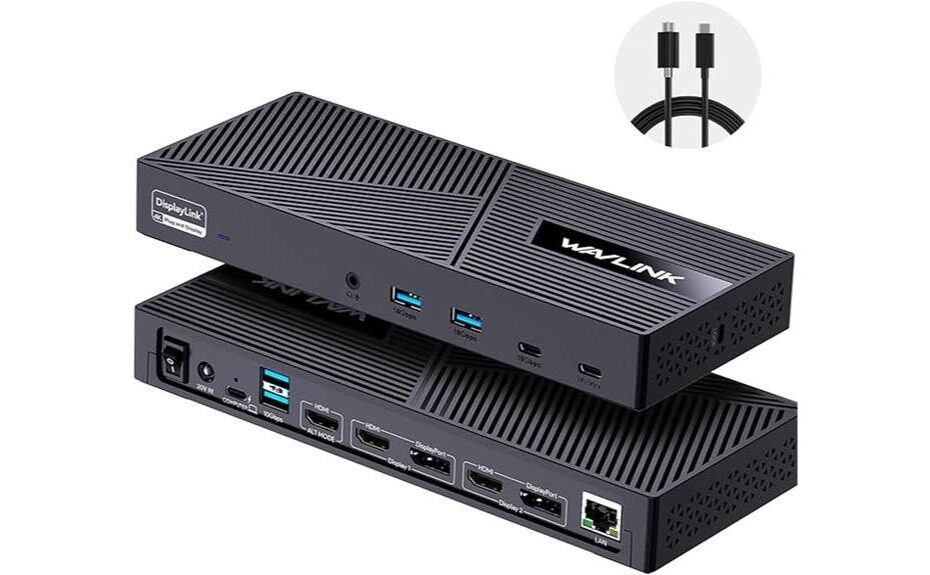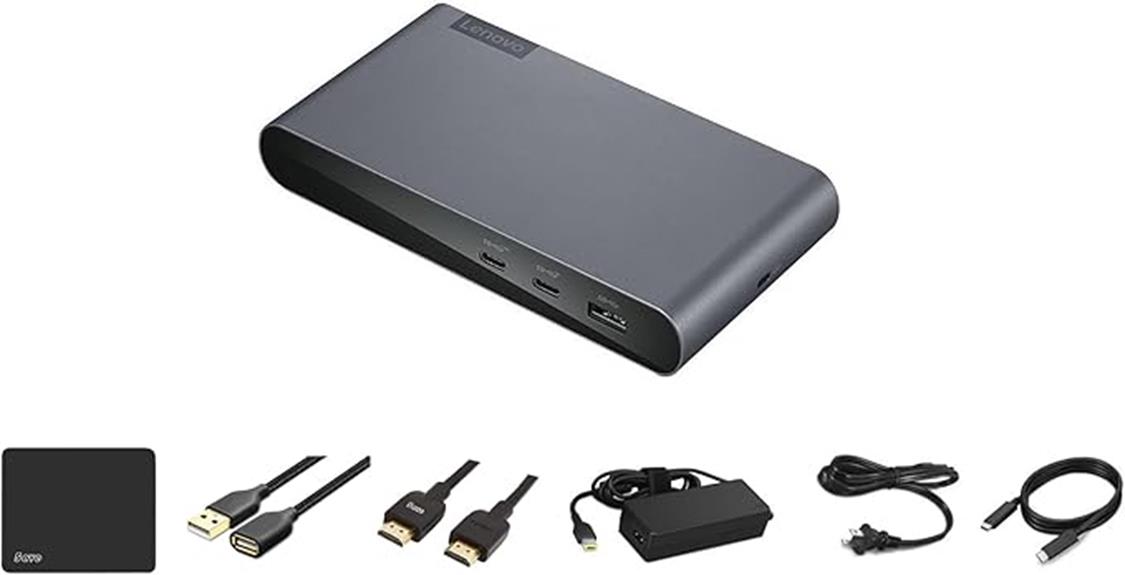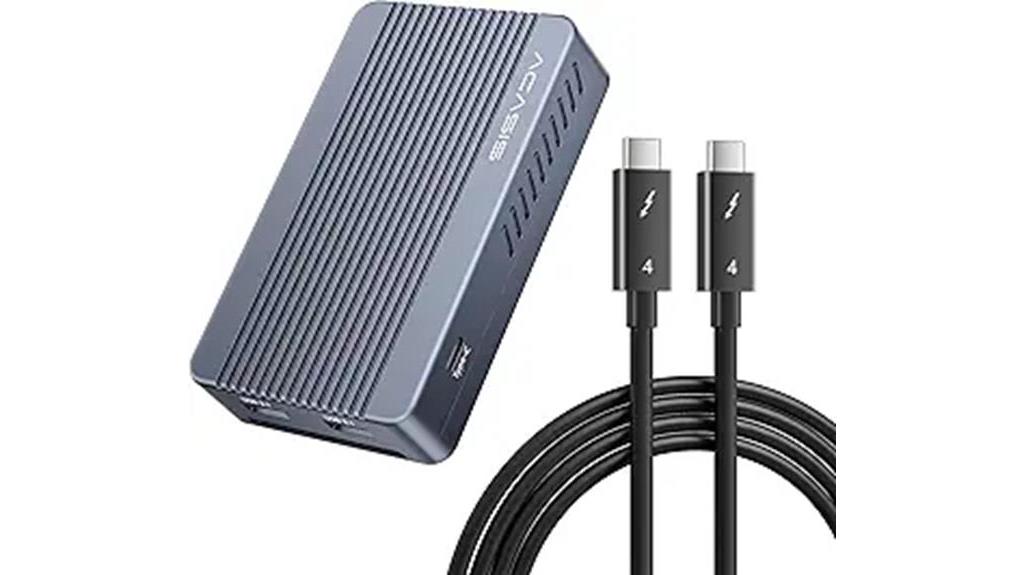



I recently explored the WAVLINK DisplayLink Docking Station, and I found it impressive for boosting productivity with multi-monitor setups. It supports triple displays via DisplayLink technology, offering crisp visuals—but I did notice some users reported flickering. The robust USB hub features multiple ports for quick device connections, along with a solid build. While the driver setup can be tricky, once I navigated that, it worked seamlessly with my devices. However, it's not ideal for streaming protected content. There's certainly more to examine about its performance and features, which I've detailed further for a clearer picture.
Key Takeaways
- Supports triple monitors with DisplayLink technology, enhancing multitasking and productivity for remote workers and professionals.
- Offers fast USB 3.1 data transfer speeds and multiple connectivity options, facilitating seamless device integration.
- Features a robust build quality but has mixed reviews regarding long-term durability and occasional hardware issues.
- Installation of drivers can be complicated; following setup tips is essential for optimal performance and stability.
- Not suitable for streaming protected content due to lack of HDCP support, limiting its use for certain media tasks.
When I first encountered the WAVLINK DisplayLink Docking Station, I was immediately impressed by its capability to support triple displays. The device utilizes DisplayLink USB Graphics Technology, which allows for seamless integration of multiple monitors. However, I quickly realized that it's not plug-and-play; proper driver installation is vital for peak performance. This requirement can be a hurdle for some users, particularly those who may not be tech-savvy. Regarding monitor compatibility, I found it supports various configurations with M1, M2, and M3 systems, but it's important to verify individual monitor specifications to avoid compatibility issues. Overall, I appreciated the advanced display options, but the driver installation process does require careful attention.
Features and Benefits
The WAVLINK DisplayLink Docking Station impresses me with its ability to support three extended displays, making multitasking a breeze. I appreciate the 10Gbps USB data transfer and Gigabit Ethernet connectivity, which enhance productivity and connectivity options. Additionally, the fast USB 3.1 ports provide efficient data transfer, essential for my workflow.
Supports 3 Extended Displays
With its ability to support three extended displays, the WAVLINK DisplayLink Docking Station stands out as a versatile solution for enhancing productivity. I found that its multi display setups greatly improve my workflow, allowing me to manage different projects simultaneously across multiple screens. The dock's monitor compatibility is impressive, accommodating various configurations through its three HDMI and two DisplayPort outputs. However, it's essential to acknowledge that while it performs well for productivity tasks, it requires driver installation, which can be a hassle. The dock doesn't support HDCP, making it less suitable for streaming protected content. Overall, this docking station is a solid choice for anyone looking to expand their display capabilities without sacrificing performance.
0Gbps USB Data Transfer
Utilizing the WAVLINK DisplayLink Docking Station's 10Gbps USB capabilities, I've experienced rapid data transfer speeds that greatly enhance my workflow. The four USB 3.1 ports deliver impressive performance, allowing me to transfer large files in mere seconds. This efficiency is a game changer, especially when I'm working with high-resolution graphics or extensive datasets. The dual USB-C ports further amplify my options, making it easy to connect multiple devices without sacrificing speed. Overall, the USB performance of this docking station notably reduces downtime, which is vital for my productivity. I've noticed that these data transfer speeds not only improve my workflow but also streamline my daily tasks, making the WAVLINK an invaluable tool in my setup.
Gigabit Ethernet Connectivity
Building upon the impressive USB capabilities, the WAVLINK DisplayLink Docking Station also offers Gigabit Ethernet connectivity, which greatly boosts internet performance. I've found that this feature markedly enhances my network stability, particularly during heavy usage, like video conferencing and large file transfers. The wired performance is consistently reliable, eliminating the lags often associated with wireless connections. I appreciate how it provides a stable and fast internet connection, even in crowded network environments. This makes it perfect for productivity tasks, where interruptions can be detrimental. Overall, the inclusion of Gigabit Ethernet connectivity not only complements the docking station's impressive features but also guarantees that my online activities remain seamless and efficient.
Fast USB 3.1 Ports
While I appreciate various features of the WAVLINK DisplayLink Docking Station, the fast USB 3.1 ports stand out as a significant advantage. With four USB 3.1 ports offering up to 10Gbps speeds, I've found the USB performance to be exceptional. Transferring large files is quick and efficient, which saves me valuable time during my workflow. I also value the data reliability these ports provide, ensuring that my devices maintain a stable connection without interruptions. Whether I'm connecting external hard drives or peripherals, the WAVLINK docking station delivers consistent performance. Overall, these fast USB 3.1 ports enhance my productivity, making this docking station a strong contender for anyone needing reliable connectivity.
Product Quality
When evaluating the product quality of the WAVLINK DisplayLink Docking Station, it becomes clear that the device boasts a solid build and a well-thought-out design. The build quality feels premium, with sturdy materials that suggest it can withstand daily use. However, some durability concerns arise from user feedback, indicating that a few units experienced hardware failures within a month. While the overall construction appears robust, these reports make me cautious about its long-term reliability. I appreciate the thoughtful layout of ports, which enhances usability, but I'd recommend keeping an eye on the device, especially during the initial months. Overall, the docking station offers a good balance of quality and functionality, albeit with some potential durability risks.
What It's Used For
I find the WAVLINK DisplayLink Docking Station particularly useful for creating a multi-monitor setup, which enhances my productivity greatly. Its robust power delivery features allow me to charge my laptop while simultaneously connecting multiple devices, streamlining my workspace. Additionally, the variety of USB connectivity options guarantees I can easily connect all my peripherals without hassle.
Multi-Monitor Setup
Many users find that a multi-monitor setup greatly enhances productivity and efficiency, particularly in professional environments. With the WAVLINK DisplayLink Docking Station, I can connect up to three monitors, greatly boosting my workflow. I appreciate the monitor compatibility with various systems, including M1, M2, and M3 devices, although I had to install drivers first. The user experience has been generally positive, with crisp displays and responsive performance when running productivity software. However, I've encountered some occasional monitor flickering, which can be frustrating. Overall, the ability to extend my desktop across multiple screens transforms how I work, allowing me to multitask effectively and keep essential applications visible simultaneously.
Power Delivery Features
The WAVLINK DisplayLink Docking Station's power delivery features considerably enhance its utility for users who rely on multiple devices. With a robust 130W power supply, it guarantees efficient power management, allowing me to charge my laptop up to 100W via USB-C while using multiple peripherals. This capability greatly boosts charging efficiency, minimizing the clutter of multiple chargers. As I connect my devices, I appreciate how the docking station maintains power to my laptop and additional accessories without overloading the system. This seamless integration means I can focus on my work without worrying about battery life. Overall, the power delivery features stand out as a key aspect of this docking station, making it a valuable asset for productivity.
USB Connectivity Options
With a variety of USB connectivity options available, the WAVLINK DisplayLink Docking Station greatly enhances productivity and device integration. It functions as a powerful USB hub, featuring four USB 3.1 ports and two USB-C ports, all supporting 10Gbps data transfer speeds. This versatility allows me to connect multiple devices seamlessly, whether I'm using external hard drives, keyboards, or mice. The device compatibility is impressive; it works with various systems, including macOS and Windows, ensuring I can integrate it into my existing setup without hassle. However, I do need to stay vigilant about driver installations to maintain ideal performance. Overall, the docking station considerably boosts my workflow, making it a worthwhile investment for anyone needing extensive USB connectivity.
Product Specifications
When examining the WAVLINK DisplayLink Docking Station, you'll find a robust set of specifications that cater to a variety of connectivity needs. Its design aesthetics are sleek and functional, making it a strong contender in market comparison with similar products. Below, I've outlined some key specifications that highlight its capabilities:
| Feature | Specification |
|---|---|
| Power Delivery | 130W (charges up to 100W) |
| Supported Displays | Up to 3 extended displays |
| USB Ports | 4x USB 3.1, 2x USB-C |
This combination of features guarantees it meets diverse user requirements, from productivity tasks to efficient multi-monitor setups. Overall, the WAVLINK Docking Station stands out for its performance and flexibility.
Who Needs This
Versatility defines who can benefit from the WAVLINK DisplayLink Docking Station. If you're engaged in remote work, this docking station is a game-changer. It allows me to connect multiple monitors, which greatly enhances my workflow and provides a productivity boost. Whether I'm juggling data analysis, video calls, or creative projects, having three extended displays lets me keep everything organized and easily accessible. For professionals who rely on various applications and multitasking, this device can streamline tasks efficiently. In addition, its fast USB ports facilitate quick file transfers, which is essential for my daily operations. Overall, anyone looking to elevate their remote work setup and maximize productivity will find the WAVLINK DisplayLink Docking Station invaluable.
Pros
The WAVLINK DisplayLink Docking Station offers numerous advantages that can greatly enhance the user experience, especially for remote workers. I've found it particularly beneficial for connecting multiple monitors and managing my workspace efficiently. Here are some standout pros:
- Triple Display Support: I can easily extend my workspace across three monitors, boosting productivity.
- Fast Data Transfer: The USB 3.1 ports provide quick file transfers, which improves my workflow.
- High Power Delivery: It charges my laptop while I work, ensuring I never run out of battery.
- Robust Build Quality: The design feels sturdy and durable, which adds to my customer satisfaction.
Cons
While the WAVLINK DisplayLink Docking Station has many strengths, it also comes with some notable drawbacks. I've encountered several issues that could deter potential users:
- Driver Issues: Installing the required drivers isn't straightforward, which can be frustrating.
- Compatibility Concerns: It doesn't support Linux, limiting its user base.
- Monitor Flickering: I've noticed occasional flickering on connected displays, which can be distracting.
- Power-Saving Settings: Users must disable USB power-saving features to maintain stable connections, adding extra steps to setup.
These drawbacks can affect overall performance and user experience, especially for those who rely on seamless connectivity for productivity tasks. It's important to weigh these cons against its strengths before making a purchase.
What Customers Are Saying
Amid various user experiences, many customers appreciate the WAVLINK DisplayLink Docking Station for its ability to connect multiple monitors seamlessly. Customer insights reveal that users find the build quality and fast USB ports particularly impressive. They often highlight its effectiveness for productivity tasks, which aligns with its intended use. However, some user experiences point out challenges, such as monitor flickering and the need for driver installation, which can deter less tech-savvy individuals. Additionally, a few customers express concerns about occasional glitches and the long-term durability of the product. Overall, while many are satisfied with its performance, it's clear that there's a mix of positive and negative feedback that potential buyers should consider carefully.
Overall Value
Considering the mixed customer feedback, evaluating the overall value of the WAVLINK DisplayLink Docking Station becomes essential for potential buyers. From my pricing analysis, it's clear that this docking station falls within a competitive price range, appealing to a broad spectrum of customer demographics. While many users appreciate its capability to connect multiple monitors and the fast USB ports, some report frustrating issues like flickering screens and driver installation headaches. This duality complicates the perceived value. For those primarily using it for productivity tasks, it may justify the investment. However, if you're seeking reliability and long-term performance, the mixed reviews may prompt you to explore alternatives before committing to a purchase.
Tips and Tricks For Best Results
To get the most out of your WAVLINK DisplayLink Docking Station, it's crucial to follow some key tips and tricks. First, tackle installation challenges by ensuring you download the latest drivers from the DisplayLink website before connecting the dock. This step can prevent many common issues related to connectivity. I've also found that optimizing performance involves disabling power-saving features for USB root hubs in your system settings; this can greatly enhance stability and prevent monitor flickering. Additionally, consider updating your BIOS for improved compatibility. Finally, if you're using multiple monitors, try to connect them in the order specified in the manual to avoid potential glitches. These simple adjustments can lead to a smoother and more efficient user experience.
Conclusion
When using the WAVLINK DisplayLink Docking Station, following the recommended tips can greatly enhance the overall experience. Despite its impressive capabilities, I did encounter some setup challenges. The necessity of installing drivers can be a hurdle for many users, and addressing USB power-saving settings is essential to prevent monitor flickering. Once I navigated these initial issues, the user experience improved considerably. The ability to connect three monitors effectively transformed my workspace, making multitasking seamless. While it's not designed for gaming, it excels in productivity tasks. Overall, if you're prepared to tackle the setup challenges, the WAVLINK DisplayLink Docking Station offers valuable functionality for enhancing your workflow.
Frequently Asked Questions
What Operating Systems Are Compatible With the WAVLINK Docking Station?
As the saying goes, "A chain is only as strong as its weakest link." For compatibility features, I found this docking station supports macOS 11+, Windows, and ChromeOS 100+, but lacks Linux operating system support.
How Do I Install the Required Drivers for This Docking Station?
To install the required drivers, I downloaded them from the manufacturer's website. This step's essential for ideal docking station functionality, as it guarantees all connected devices work seamlessly without issues like flickering or disconnections.
Can I Use This Docking Station With Linux Systems?
When I tried connecting this docking station to my Linux system, it felt like forcing a square peg into a round hole. Unfortunately, Linux compatibility isn't supported, affecting performance benchmarks for my intended use.
What Should I Do if My Monitors Flicker?
If my monitors flicker, I troubleshoot by checking display settings and ensuring all drivers are updated. I also adjust resolution and refresh rates, and sometimes disable USB power-saving features to stabilize connections.
Is There a Way to Reset the Docking Station if Issues Occur?
If I encounter issues, I follow troubleshooting steps like disconnecting and reconnecting power. I also utilize reset methods by pressing the reset button or unplugging it for a few minutes to refresh the connection.
Disclosure: As an Amazon Associate, I earn from qualifying purchases.





